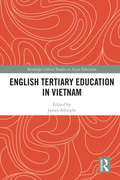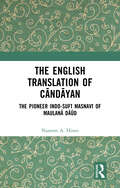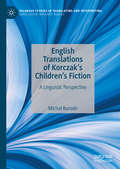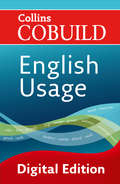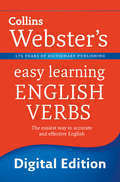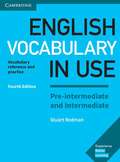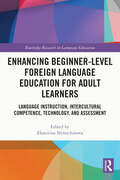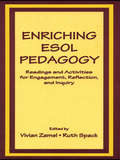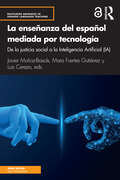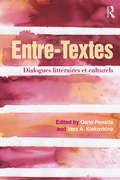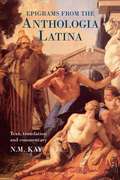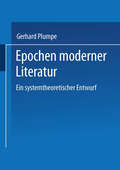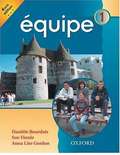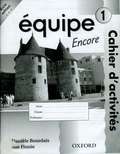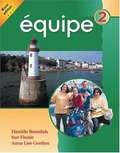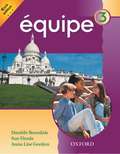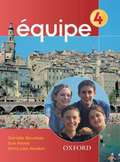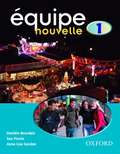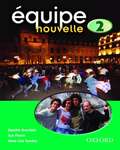- Table View
- List View
English Tertiary Education in Vietnam (Routledge Critical Studies in Asian Education)
by James AlbrightAs part of a long series of Vietnam’s policy objectives, English education has been identified as key to improving the quality of its rapidly expanding tertiary institutions and is crucial to the larger aim of modernising and internationalising its economy. Bringing together a wide range of Vietnamese and foreign English education scholars, and tertiary educational practitioners, this book documents the significant progress and challenges in the realisation of Vietnam’s English language policies as they are enacted in the higher education sector. Changes to Vietnam’s higher education system remain unstable, unsystematic, and insubstantial. This book provides insights into how recent Vietnamese government policy is providing for a substantial and comprehensive renewal of Vietnam’s tertiary education as part of their 2020 plan. Academics and students of English education, language policy, and nation building within the context of increased globalisation and marketisation in developing nations and Vietnam, in particular, should find this book valuable.
The English Translation of Cāndāyan: The Pioneer Indo-Sufī Masnavī of Maulanā Dāūd
by Naseem A. HinesThis book is the first English translation of Cāndāyan, the pioneer work in a long tradition of Indian-Sufi love narratives. The story was adapted from an oral epic Chanaini, popular in the Awadhi speaking region of north India in the fourteenth century. The early manuscripts of Cāndāyan, though composed in the Awadhi dialect, were recorded in the Persian script. Each stanza-like unit is introduced by a phrase or sentences in the Persian language style, making it necessary for a reader to know the Persian script and language, as well as the Awadhi dialect. This somewhat limits the access to fully explore Cāndāyan. In addition to this, the esoteric interpretation, which is the distinguishing feature that gives the Indian-Sufi masnavī literature its unique identity, was also not yet realized. Cāndāyan deserves to be celebrated and recognized because it marks the beginning of the indigenizing process of the masnavī in India, and served as a model for this literary genre for the next 540 years. A serious study of Maulana Daud’s Cāndāyan, composed in 1379, in the reign of Firoz Shah Tughlaq, did not begin until well into the twentieth century because only a few pages of its manuscript folios were discovered at a time, in various academic institutions and museums around the world. Cāndāyan is a fascinating study of the blending of the features of the Persian masnavī with the features of the Hindi premākhyān narratives and the features of the medieval Jain literature. Even today, annually in the Mahakoshala region Cāndāyan is presented in the form of drama and in the folk-song and play forms. Print edition not for sale in South Asia (India, Sri Lanka, Nepal, Bangladesh, Pakistan and Bhutan)
The English Translation of Cāndāyan: The Pioneer Indo-Sufī Masnavī of Maulanā Dāūd
by Naseem A. HinesThis book is the first English translation of Cāndāyan, the pioneer work in a long tradition of Indian-Sufi love narratives. The story was adapted from an oral epic Chanaini, popular in the Awadhi speaking region of north India in the fourteenth century. The early manuscripts of Cāndāyan, though composed in the Awadhi dialect, were recorded in the Persian script. Each stanza-like unit is introduced by a phrase or sentences in the Persian language style, making it necessary for a reader to know the Persian script and language, as well as the Awadhi dialect. This somewhat limits the access to fully explore Cāndāyan. In addition to this, the esoteric interpretation, which is the distinguishing feature that gives the Indian-Sufi masnavī literature its unique identity, was also not yet realized. Cāndāyan deserves to be celebrated and recognized because it marks the beginning of the indigenizing process of the masnavī in India, and served as a model for this literary genre for the next 540 years. A serious study of Maulana Daud’s Cāndāyan, composed in 1379, in the reign of Firoz Shah Tughlaq, did not begin until well into the twentieth century because only a few pages of its manuscript folios were discovered at a time, in various academic institutions and museums around the world. Cāndāyan is a fascinating study of the blending of the features of the Persian masnavī with the features of the Hindi premākhyān narratives and the features of the medieval Jain literature. Even today, annually in the Mahakoshala region Cāndāyan is presented in the form of drama and in the folk-song and play forms. Print edition not for sale in South Asia (India, Sri Lanka, Nepal, Bangladesh, Pakistan and Bhutan)
English Translations of Korczak’s Children’s Fiction: A Linguistic Perspective (Palgrave Studies in Translating and Interpreting)
by Michał BorodoThis book investigates major linguistic transformations in the translation of children’s literature, focusing on the English-language translations of Janusz Korczak, a Polish-Jewish children’s writer known for his innovative pedagogical methods as the head of a Warsaw orphanage for Jewish children in pre-war Poland. The author outlines fourteen tendencies in translated children’s literature, including mitigation, simplification, stylization, hyperbolization, cultural assimilation and fairytalization, in order to analyse various translations of King Matt the First, Big Business Billy and Kaytek the Wizard. The author then addresses the translators’ treatment of racial issues based on the socio-cultural context. The book will be of use to students and researchers in the field of translation studies, and researchers interested in children’s literature or Janusz Korczak.
English Usage (Collins Cobuild)
by Collins CobuildThe new second edition of the Collins COBUILD English Usage has been specially designed for upper-intermediate and advanced students and teachers of English. Its comprehensive coverage of different areas of the English language helps learners to use the language naturally and effectively.
English Verbs (Collins Webster’s Easy Learning)
by CollinsCollins Easy Learning Verbs is an accessible introduction to English verbs, tenses and morphology.
English Vocabulary in Use Pre-intermediate and Intermediate Book with Answers (Fourth Edition) (PDF): Vocabulary Reference And Practice
by Stuart RedmanThe words you need to communicate with confidence. Vocabulary explanations and practice for pre-intermediate and intermediate level (B1) learners of English. Perfect for both self-study and classroom activities. Quickly expand your vocabulary with 100 units of easy to understand explanations and practice exercises. Be confident about what you are learning, thanks to Cambridge research into how English is really spoken and written, and get better at studying by yourself, with units on learning vocabulary, personalised practice and an easy to use answer key.
Enhancing Beginner-Level Foreign Language Education for Adult Learners: Language Instruction, Intercultural Competence, Technology, and Assessment (Routledge Research in Language Education)
by Ekaterina NemtchinovaThis book is an authoritative text that explores best classroom practices for engaging adult learners in beginner-level foreign language courses. Built around a diverse range of international research studies and conceptual articles, the book covers four key issues in teaching language to novice students: development of linguistic skills; communicative, and intercultural competence; evaluation and assessment; and the use of technology. Each chapter includes teaching insights that are supported by critical research and can be practically applied across languages to enhance instructional strategies and curriculum designs. The text also aims to build intercultural competence, harness technology, and design assessment to stimulate effective learning in formal instructional settings including colleges, universities, and specialist language schools. With its broad coverage of language pedagogy at the novice level, this book is a must read for graduate students, scholars, researchers, and practitioners in the fields of language education, second language acquisition, language teaching and learning, and applied linguistics.
Enhancing Beginner-Level Foreign Language Education for Adult Learners: Language Instruction, Intercultural Competence, Technology, and Assessment (Routledge Research in Language Education)
by Ekaterina NemtchinovaThis book is an authoritative text that explores best classroom practices for engaging adult learners in beginner-level foreign language courses. Built around a diverse range of international research studies and conceptual articles, the book covers four key issues in teaching language to novice students: development of linguistic skills; communicative, and intercultural competence; evaluation and assessment; and the use of technology. Each chapter includes teaching insights that are supported by critical research and can be practically applied across languages to enhance instructional strategies and curriculum designs. The text also aims to build intercultural competence, harness technology, and design assessment to stimulate effective learning in formal instructional settings including colleges, universities, and specialist language schools. With its broad coverage of language pedagogy at the novice level, this book is a must read for graduate students, scholars, researchers, and practitioners in the fields of language education, second language acquisition, language teaching and learning, and applied linguistics.
Enriching Esol Pedagogy: Readings and Activities for Engagement, Reflection, and Inquiry
by Vivian Zamel Ruth SpackEnriching ESOL Pedagogy: Readings and Activities for Engagement, Reflection, and Inquiry is a collection of thought-provoking articles and activities designed to engage practicing and prospective ESOL teachers in an ongoing process of reflecting on, critically examining, and investigating theory and practice. Its twofold purpose is to provide a theoretical perspective and to offer ways for making the teaching of English to speakers of other languages (ESOL) meaningful for both teachers and learners. Underlying the activities and the readings themselves is the assumption that teachers need to play a role in exploring, shaping, and theorizing the work they do. The readings included represent a range of genres. They are informed by a common philosophical perspective about language acquisition and treat language teaching and learning holistically. The book is organized into five integrated units that: * raise questions about conventional notions of methods; * take into account the complicated nature of real classrooms; * provide theoretical principles for teaching that promotes language acquisition; * include rich descriptions of actual classroom experiences; and * question assumptions about language and literacy. Each set of readings begin with a "Before Reading" section and is followed by "Reflecting on the Readings," "Reading for Further Reflection," and "Suggested Projects for Inquiry" sections. This volume is a valuable resource for practicing and prospective teachers in the field of TESOL who work with diverse student populations--at all levels--in both mainstream and ESL/bilingual settings.
Enriching Esol Pedagogy: Readings and Activities for Engagement, Reflection, and Inquiry
by Vivian Zamel Ruth SpackEnriching ESOL Pedagogy: Readings and Activities for Engagement, Reflection, and Inquiry is a collection of thought-provoking articles and activities designed to engage practicing and prospective ESOL teachers in an ongoing process of reflecting on, critically examining, and investigating theory and practice. Its twofold purpose is to provide a theoretical perspective and to offer ways for making the teaching of English to speakers of other languages (ESOL) meaningful for both teachers and learners. Underlying the activities and the readings themselves is the assumption that teachers need to play a role in exploring, shaping, and theorizing the work they do. The readings included represent a range of genres. They are informed by a common philosophical perspective about language acquisition and treat language teaching and learning holistically. The book is organized into five integrated units that: * raise questions about conventional notions of methods; * take into account the complicated nature of real classrooms; * provide theoretical principles for teaching that promotes language acquisition; * include rich descriptions of actual classroom experiences; and * question assumptions about language and literacy. Each set of readings begin with a "Before Reading" section and is followed by "Reflecting on the Readings," "Reading for Further Reflection," and "Suggested Projects for Inquiry" sections. This volume is a valuable resource for practicing and prospective teachers in the field of TESOL who work with diverse student populations--at all levels--in both mainstream and ESL/bilingual settings.
La enseñanza del español mediada por tecnología: de la justicia social a la Inteligencia Artificial (IA) (Routledge Advances in Spanish Language Teaching)
by Javier Muñoz-Basols Mara Fuertes Gutiérrez Luis CerezoLa enseñanza del español mediada por tecnología ofrece una nutrida panorámica de la investigación actual y de las estrategias didácticas sobre la integración de la tecnología en la enseñanza y el aprendizaje del español. Estructurado en trece capítulos esenciales, el libro constituye una hoja de ruta diseñada para que los profesionales de la lengua incorporen de manera eficaz la tecnología en cualquier entorno de aprendizaje: presencial, híbrido o en línea.Características principales: marco metodológico Planificar, Personalizar e Implementar (PPI) con elementos teóricos y prácticos sobre tecnología y enseñanza de lenguas selección de temas: accesibilidad, diseño curricular, actitudes de los docentes y diversidad; estrategias para gestionar la motivación, ansiedad, interacción y feedback; pautas para gestionar la enseñanza híbrida y en línea, inmersión lingüística digital, podcasts y narraciones digitales; gamificación e Inteligencia Artificial (IA) estructura consistente: conceptos clave, directrices metodológicas, consideraciones prácticas y referencias adicionales estrategias pedagógicas para apoyar la enseñanza de lenguas mediada por tecnología Escrito por un elenco internacional de investigadores, el libro es un recurso único para incorporar prácticas eficientes en la enseñanza de idiomas mediada por tecnología.La enseñanza del español mediada por tecnología offers a thorough exploration of current research and instructional strategies related to the integration of technology into the teaching and learning of Spanish. It consists of thirteen chapters that serve as a roadmap designed for language professionals to effectively incorporate technology into their learning environments: face-to-face, hybrid, or fully online.Key features: Three major sections presented as a framework, Planning, Personalizing and Implementing (PPI), that blend both theoretical and practical elements of technology; A unique range of topics, such as accessibility, curriculum development, teachers' beliefs and diversity; strategies for managing motivation, anxiety, interaction, and feedback; tips for effective hybrid and online teaching, digital language immersion, use of podcasts and digital storytelling, gamification, and Artificial Intelligence (AI); A consistent format for all chapters, with key concepts, methodological guidelines, practical considerations, and references for further exploration of each topic covered; Clear explanations and numerous scenarios that help readers comprehend the various factors that influence technology-assisted language learning; Support for educators in navigating the challenges that arise in technology-enhanced learning and teaching, with a focus on pedagogical best practices; Tips for educators to transition from a conventional curriculum approach to a more creative and engaging one that maximizes learning opportunities mediated by technology. Written by an international team of scholars, La enseñanza del español mediada por tecnología is a unique resource for Spanish language professionals at any context who wish to improve and enhance their teaching techniques. The book will be equally valuable to teachers of other languages as it contains relevant material on best practices and classroom management in technology-mediated education.
La enseñanza del español mediada por tecnología: de la justicia social a la Inteligencia Artificial (IA) (Routledge Advances in Spanish Language Teaching)
La enseñanza del español mediada por tecnología ofrece una nutrida panorámica de la investigación actual y de las estrategias didácticas sobre la integración de la tecnología en la enseñanza y el aprendizaje del español. Estructurado en trece capítulos esenciales, el libro constituye una hoja de ruta diseñada para que los profesionales de la lengua incorporen de manera eficaz la tecnología en cualquier entorno de aprendizaje: presencial, híbrido o en línea.Características principales: marco metodológico Planificar, Personalizar e Implementar (PPI) con elementos teóricos y prácticos sobre tecnología y enseñanza de lenguas selección de temas: accesibilidad, diseño curricular, actitudes de los docentes y diversidad; estrategias para gestionar la motivación, ansiedad, interacción y feedback; pautas para gestionar la enseñanza híbrida y en línea, inmersión lingüística digital, podcasts y narraciones digitales; gamificación e Inteligencia Artificial (IA) estructura consistente: conceptos clave, directrices metodológicas, consideraciones prácticas y referencias adicionales estrategias pedagógicas para apoyar la enseñanza de lenguas mediada por tecnología Escrito por un elenco internacional de investigadores, el libro es un recurso único para incorporar prácticas eficientes en la enseñanza de idiomas mediada por tecnología.La enseñanza del español mediada por tecnología offers a thorough exploration of current research and instructional strategies related to the integration of technology into the teaching and learning of Spanish. It consists of thirteen chapters that serve as a roadmap designed for language professionals to effectively incorporate technology into their learning environments: face-to-face, hybrid, or fully online.Key features: Three major sections presented as a framework, Planning, Personalizing and Implementing (PPI), that blend both theoretical and practical elements of technology; A unique range of topics, such as accessibility, curriculum development, teachers' beliefs and diversity; strategies for managing motivation, anxiety, interaction, and feedback; tips for effective hybrid and online teaching, digital language immersion, use of podcasts and digital storytelling, gamification, and Artificial Intelligence (AI); A consistent format for all chapters, with key concepts, methodological guidelines, practical considerations, and references for further exploration of each topic covered; Clear explanations and numerous scenarios that help readers comprehend the various factors that influence technology-assisted language learning; Support for educators in navigating the challenges that arise in technology-enhanced learning and teaching, with a focus on pedagogical best practices; Tips for educators to transition from a conventional curriculum approach to a more creative and engaging one that maximizes learning opportunities mediated by technology. Written by an international team of scholars, La enseñanza del español mediada por tecnología is a unique resource for Spanish language professionals at any context who wish to improve and enhance their teaching techniques. The book will be equally valuable to teachers of other languages as it contains relevant material on best practices and classroom management in technology-mediated education.
Entre-Textes: Dialogues littéraires et culturels
by Oana Panaïté Vera A. KlekovkinaEntre-Textes introduces advanced students of French to the richness of the Francophone world through literature from the Middle Ages to the 21st century. The course anthology is divided into fourteen modules, each of which pairs a classical text with a modern one. Students are guided to read works from different periods of time and cultural origin and consider how these echo, complement or question each other. Through comparing and contrasting the texts, students will develop a new approach to reading literature while simultaneously reinforcing linguistic and cultural competencies. Suitable for advanced students of French and featuring texts from across the French-speaking world, Entre-Textes is an innovative course anthology with a flexible structure and versatile methodology.
Entre-Textes: Dialogues littéraires et culturels
by Oana Panaïté Vera A. KlekovkinaEntre-Textes introduces advanced students of French to the richness of the Francophone world through literature from the Middle Ages to the 21st century. The course anthology is divided into fourteen modules, each of which pairs a classical text with a modern one. Students are guided to read works from different periods of time and cultural origin and consider how these echo, complement or question each other. Through comparing and contrasting the texts, students will develop a new approach to reading literature while simultaneously reinforcing linguistic and cultural competencies. Suitable for advanced students of French and featuring texts from across the French-speaking world, Entre-Textes is an innovative course anthology with a flexible structure and versatile methodology.
Epigrams from the Anthologia Latina: Text,Translation and Commentary
by N. M. KayThis new scholarly edition consists of the Latin text, with translation and detailed commentary, of a sequence of epigrams from the Anthologia Latina (Shackleton Bailey 78-188). The introduction discusses whether these epigrams constitute a unified collection and are the work of a single author, examines their likely date and place of composition – which, it is argued, is North Africa under Vandal rule –, and sets them in their cultural context. The line-by-line commentary covers issues of literary, linguistic and historical significance. Although text and interpretation of these pieces present frequent difficulties, the author confirms that they make up a fascinating collection of considerable importance and merit, contrary to the low reputation generally associated with the Anthologia Latina. The book will be of great interest to students of Latin literature and language in general, the epigram tradition in particular, and the culture of Vandal Africa.
Epigrams from the Anthologia Latina: Text,Translation and Commentary
by N. M. KayThis new scholarly edition consists of the Latin text, with translation and detailed commentary, of a sequence of epigrams from the Anthologia Latina (Shackleton Bailey 78-188). The introduction discusses whether these epigrams constitute a unified collection and are the work of a single author, examines their likely date and place of composition – which, it is argued, is North Africa under Vandal rule –, and sets them in their cultural context. The line-by-line commentary covers issues of literary, linguistic and historical significance. Although text and interpretation of these pieces present frequent difficulties, the author confirms that they make up a fascinating collection of considerable importance and merit, contrary to the low reputation generally associated with the Anthologia Latina. The book will be of great interest to students of Latin literature and language in general, the epigram tradition in particular, and the culture of Vandal Africa.
Epochen moderner Literatur: Ein systemtheoretischer Entwurf
by Gerhard PlumpeVor dem Hintergrund des oft beklagten Fehlens konsistenter Epochenbegriffe stellt das Buch eine Neugliederung der Geschichte moderner deutscher Literatur vom ausgehenden 18. Jahrhundert bis in die Gegenwart vor. Mit Hilfe systemtheoretischer Kategorien werden fünf markante Perioden (Romantik, Realismus, Ästhetizismus, Avantgarde, Postismus) unterschieden, die sich auf ein explizites Literaturkonzept beziehen, untereinander homogen und an die gesamteuropäische Literaturevolution anschließbar sind.
Équipe 1: Student Book (PDF)
by Daniele Bourdais Anna Lise Gordon Sue FinnieFrom day one with Equipe your students will enjoy learning French. Not only because of all the enjoyable and exciting features - the ongoing storyline featuring four French teenagers, the songs and cartoons, the website -nbsp;but because they will get to grips with French and become more confident in using language accurately.nbsp; Part 1 has: a systematic, coherent, and rigorous approach to grammar clear objectives for each double-page spread differentiation opportunities; En Plus sections on the page and at the back of the Students' Books key language highlighted for ease of reference.
Équipe 1 (PDF)
by Sue Finnie Daniele Bourdaiséquipe is a popular series that combines rigorous grammar and language learning with a fun and motivating approach that suits all students. From day one students will enjoy learning French. Not only because of all the enjoyable and exciting features - the ongoing storyline featuring four French teenagers, the songs and cartoons, the website - but because they will develop an understanding of French and become confident in using language accurately. Part 1 Provides a strong emphasis on grammar teaching, pronunciation practice and developing students' personal study skills and learning strategiesClear objectives for each double-page spreadKey language highlighted for ease of referenceTwo parallel workbooks for reinforcement and extension.
Équipe 2: Student Book (PDF)
by Daniele Bourdais Anna Lise Gordon Sue FinnieEquipe Part 2 builds on the foundations laid in Part 1. Part 2 has a thorough approach to grammar, clear objectives with key language highlighted, and a strong focus on study skills. Encore section on the page of the Students' Book to provide consolidation for less able students Dictionnaire sections to encourage the development of dictionary skills A soap-style story at the start of each unit to introduce new language in context. The soap-opera features the same teenage characters as in Equipe 1 - but now a year older!
Équipe 3: Student Book (PDF)
by Daniele Bourdais Anna Lise Gordon Sue FinniePart 3 continues to provide clear progression and excellent preparation for GCSE/Standard Grade. Activities for National Curriculum levels 2-7 in line with revised National Curriculum Attainment Target levels Differentiated workbooks for reinforcement and extension which enable you to keep using Equipe with the whole ability range Full consolidation of language learnt in Parts 1 and 2, in particular work with tenses and giving options Extended En Plus and Encore sections for greater differentiation Language presented in a meaningful context: each of the six units is set in a different part of France, and also on the Caribbean island of Guadeloupe, each focusing on a teenager who lives in that area.
Équipe 4: Student Book (PDF)
by Daniele Bourdais Anna Lise Gordon Sue FinnieEquipe 4 completes this stimulating four-part French course, catering for a wide range of abilities. Ideal for the new GCSEs, it comprises: fully cross-referenced to all exam syllabusesnbsp; complete differentiation in a single volume Students' Booknbsp; clear grammatical progression from Key Stage 3 to 4nbsp; continued development of language learning skills, including exam preparationnbsp; encourages independent study through specific coursework guidance and self-study cassettenbsp; integrated ICT componentnbsp; special NEAB edition of the Repromasters.
Équipe nouvelle 1: Student Book (PDF)
by Bourdais Daniele Anna Lise Gordon Sue FinnieFirst part of new Framework edition of the popular 11 to 16 French course. It has all the attributes of the original edition of Équipe, revised to meet the requirements of the MFL Framework. It has been reworked in response to suggestions from Équipe users. Content has been made clearer and more accessible. Retains all the most popular features of the first edition. Features: fully supported broad-ability French programme complete with ICT and Coursemaster for planning revised to meet the requirements of the MFL framework photostory of characters based in Dieppe active-learning grammar section.
Équipe nouvelle 2: Student Book (PDF)
by Daniele Bourdais Anna Lise Gordon Sue FinnieSecond level of updated version of the popular 11- 16 French course. It has all the attributes of the original edition of Equipe, revised to meet the reuqirements of the Framework. It has been reworked in response to suggestions from Equipe users. Content has been made clearer and more accessible. Retains all the most popular features of the first edition. Features Revised to meet the requirements of the MFL framework.
